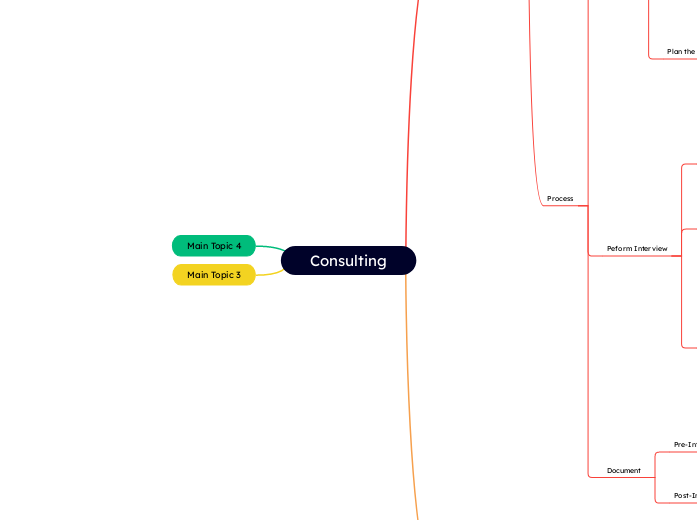por Jimmy Newman 12 meses atrás
139
Consulting - Mind Map

por Jimmy Newman 12 meses atrás
139

Mais informações
Example Hypothesis:
Validation Steps:
Downtime Analysis: Review historical data on network outages to identify patterns and assess the impact of redundancy mechanisms.
Simulation Tests: Conduct failover and redundancy tests to see how the network responds to simulated failures.
Configuration Analysis: Examine network configurations to ensure redundancy features are correctly implemented.
Inventory Review: Document all existing redundancy mechanisms, such as backup links, redundant hardware, and failover protocols.
Hypothesis:
Implementing additional redundancy in the network infrastructure will significantly reduce downtime in the event of hardware failures or network disruptions.
Problem Statement:
The current network lacks sufficient redundancy, which could lead to significant downtime in the event of a hardware failure or network disruption.
Hypothesis 3
Subject Area 3 Problem Statements
Hypothesis 2
Subject Area 2 Problem Statements
Hypothesis 1
Subject Area 1 Problem Statements
Post-Interview
Document analysis and changes to the hypothesis
Document the results of the meeting aligned by topic/question
Pre-Interview
Document the questions that will be reviewed.
Document the hypothisis for the topics being discussed.
Close the meeting
Recap with the Project Team
Delivery Team
Account Team (if appropriate)
PMO
Client
Thank them for the time.
Discuss any next steps for the project as appropriate.
Review any follow-up work.
Review what was covered.
Introductions and expectation setting
Whoever is the first interview should perform the meeting introductions
Review the topic to be discussed
Review the purpose of the meeting and the desired results, outcome, benefit of the meeting.
Introduce the interviewers
Stay focused
As the note take, prompt the interviewer appropriately about any missed questions so they can ask them. Help keep them on track.
The consultant in the note taking role is responsible for making sure all the topic questions the interviewer needs to ask get answered.
Plan the interview execution.
If it is a complex conversation, or there are materials to review, do a mock run of the interview or meeting.
Plan the transition of questing back and forth including exactly how you will do the handoff. How will each of you know when to hand off or when to take over.
The two interviewers should determine who will ask which questions.
If appropriate and beneficial to the interview, provide the client with some topics or high level questions that will be discussed to help them prepare.
Set aside the proper amount of time per resource for the process of each interview/workshop. The standard ratio for an interview is 4:1:2 as a guideline is: - 4 hours of preparation for the meeting. - 1 hour meeting/interview. - 2 hours of post meeting analysis and documentation.
Plan and prepare for the interviews
Align interview questions based on the current hypothisis associated with the topic(s) that will be discussed in the interview.
Prepare a set of topics and questions that are the focus of the interview
Topics can be lead by the lead interviewer or the two consultants can take turns in the role of interviewer/note taker based on assigned topic
Questions can be broken into topics
Align all interviews with the desired outcome or deliverables that needs to be created.
One to take notes and get clarity
One to lead the conversation